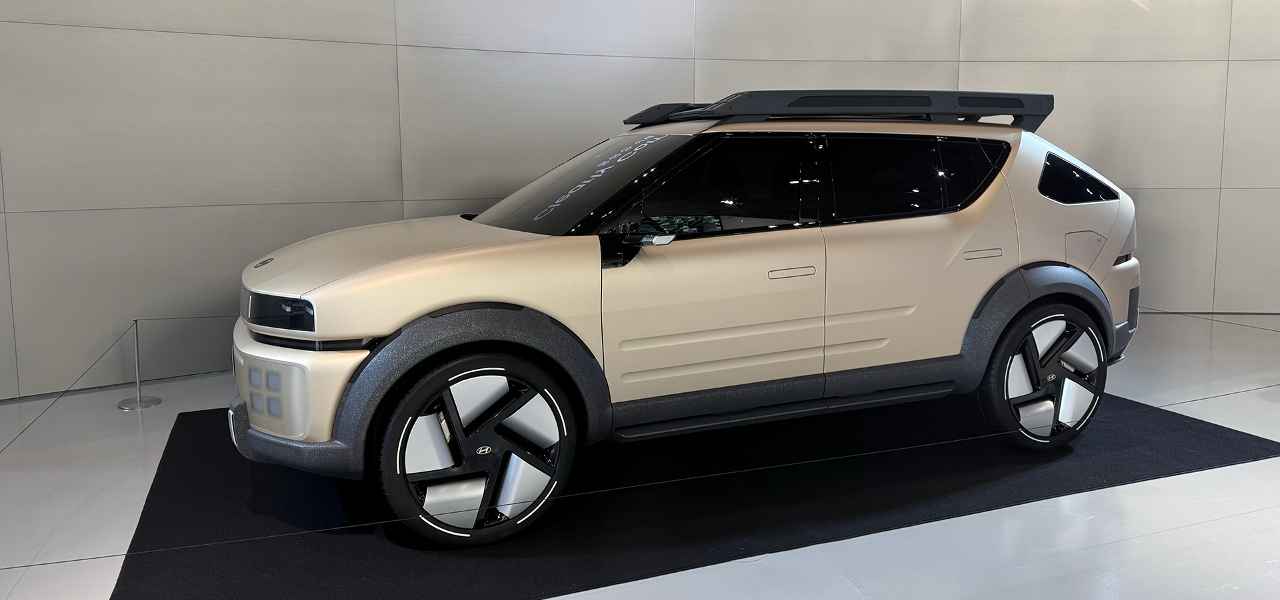 现代汽车推出了Initium燃料电池概念车,并计划于2025年上半年量产。(Sebastian Blanco)
现代汽车推出了Initium燃料电池概念车,并计划于2025年上半年量产。(Sebastian Blanco)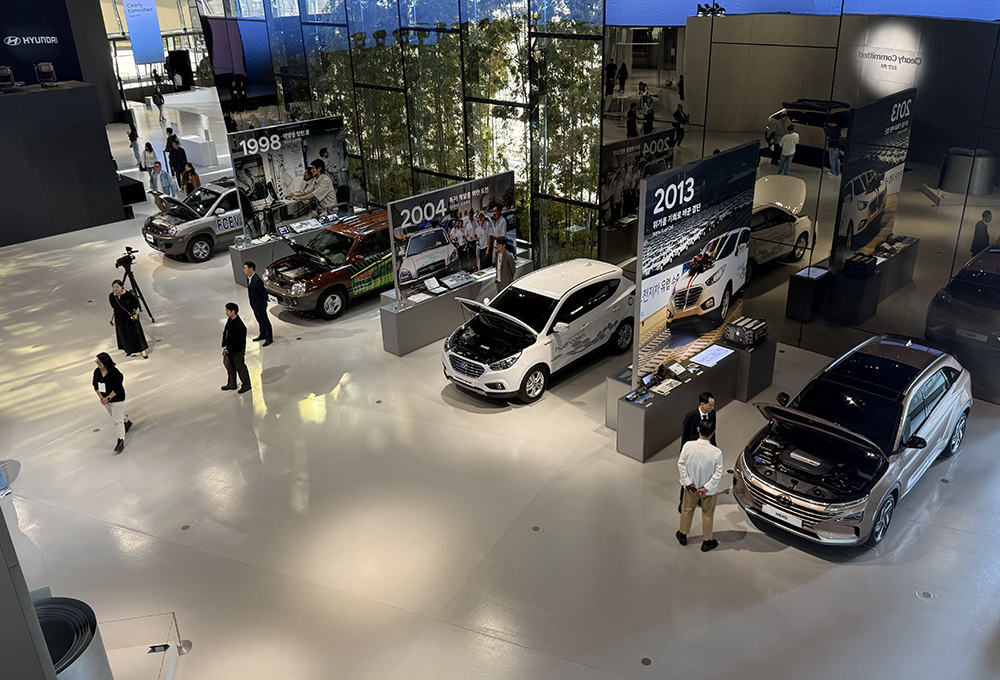 现代汽车Way Week期间,在首尔现代汽车高阳工作室展出了之前的氢燃料电池汽车。(Sebastian Blanco)
现代汽车Way Week期间,在首尔现代汽车高阳工作室展出了之前的氢燃料电池汽车。(Sebastian Blanco) 2024款Polaris I FCEV使用的零部件。(Sebastian Blanco)
2024款Polaris I FCEV使用的零部件。(Sebastian Blanco)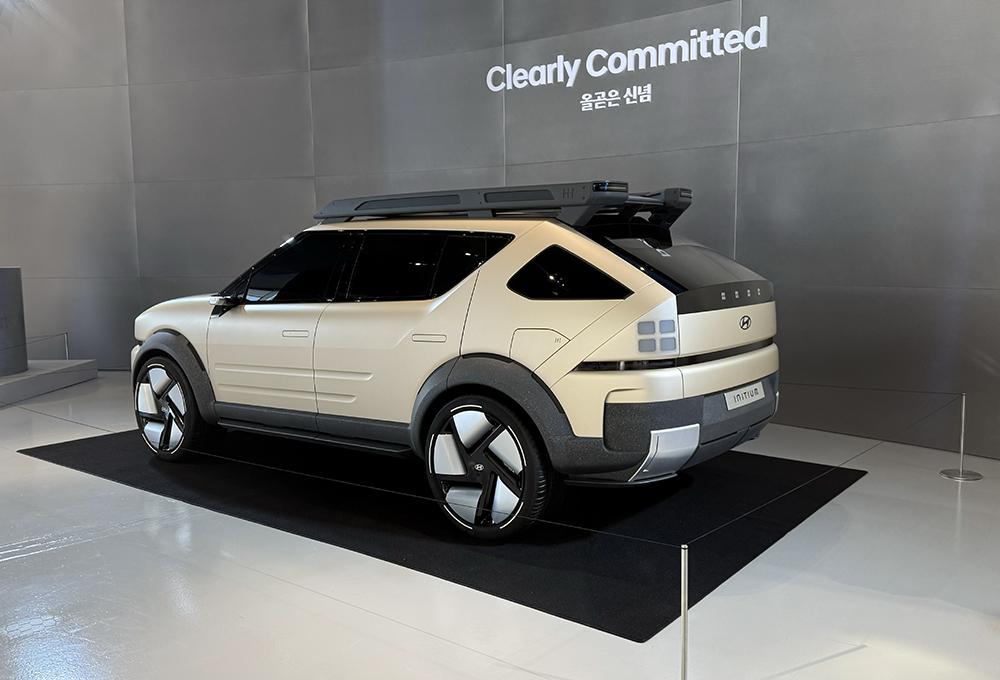 Initium的续航里程将超过650公里(404英里),使用的发动机最大输出功率为150千瓦。(Sebastian Blanco)
Initium的续航里程将超过650公里(404英里),使用的发动机最大输出功率为150千瓦。(Sebastian Blanco)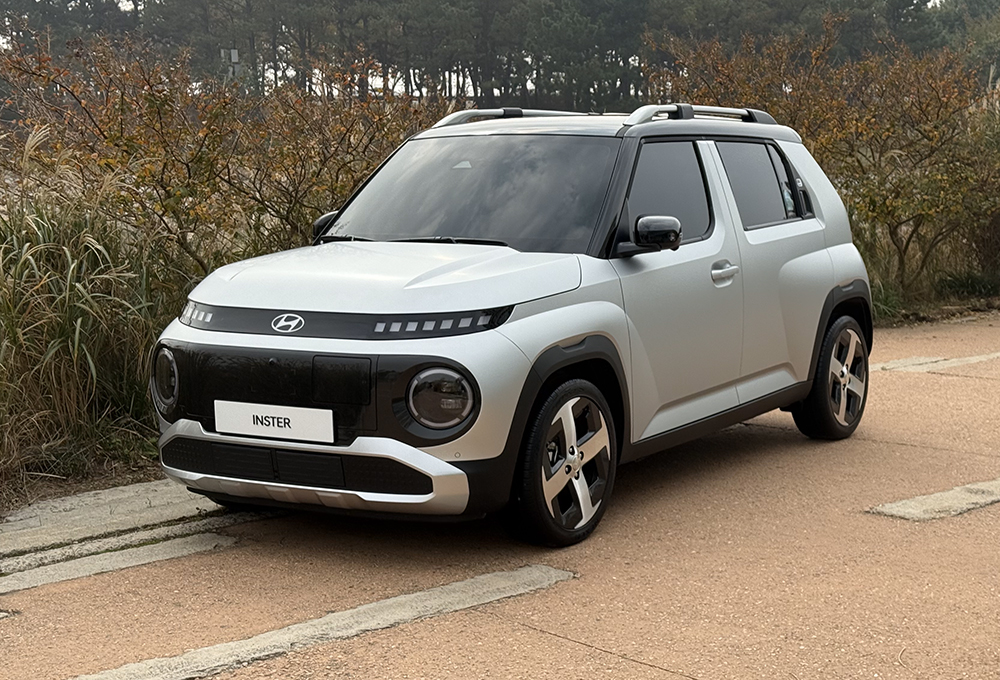 现代Inster是一款城市电动车,不会在北美销售,但会在世界其他大部分地区出现。(Sebastian Blanco)
现代Inster是一款城市电动车,不会在北美销售,但会在世界其他大部分地区出现。(Sebastian Blanco)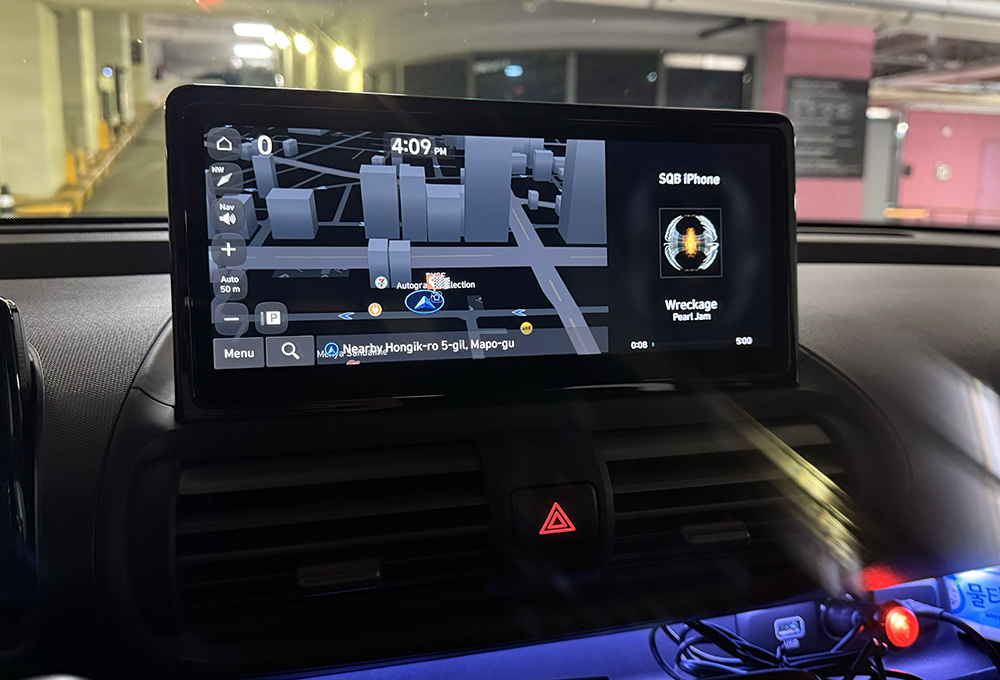 两个10.25英寸(260毫米)的信息中央和仪表显示屏在Inster中提供安全和娱乐信息。(Sebastian Blanco)
两个10.25英寸(260毫米)的信息中央和仪表显示屏在Inster中提供安全和娱乐信息。(Sebastian Blanco)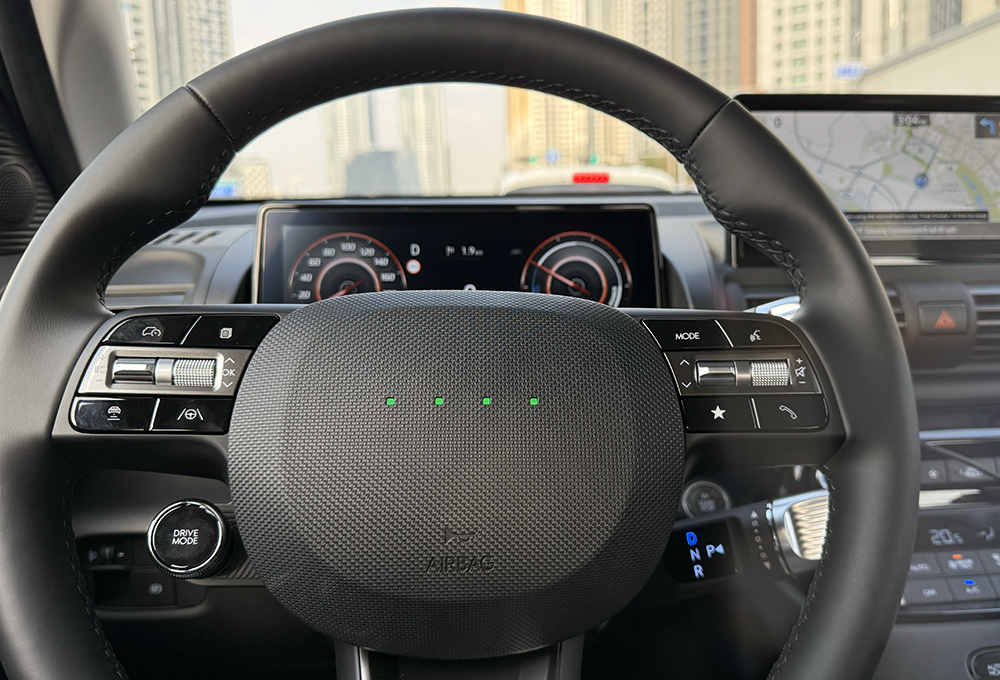 其他现代电动车的驾驶者会认出Inster方向盘上的四点设计。(Sebastian Blanco)
其他现代电动车的驾驶者会认出Inster方向盘上的四点设计。(Sebastian Blanco)
现代汽车采取广泛布局的战略具有其合理性。在2024年8月公布“Hyundai Way”战略之际,现代汽车就确立了“灵活响应市场环境并关注汽车电气化”的数个关键战略目标。为此,现代汽车计划于2033年前在Hyundai Way战略上投入120.5万亿韩元(约合850亿美元),用于达成以下目标:通过研发“升级版下一代混合动力系统”,实现到2030年混合动力汽车数量翻倍(从7款增至14款),且全系电动车产品达到21款的目标;研发经济型镍锰钴氧化物(NCM)电池;以及实现自动驾驶汽车代工的商业化。
下一代TMED(Transmission Mounted Electric Drive)混合动力系统将成为现代混动汽车扩张战略的重心,届时Genesis品牌的所有车型(纯电动车除外)都将提供混合动力版本。现代汽车表示,与当前系统相比,新一代动力系统将“显著提升性能和燃油效率”。TMED-II混合动力系统会从2025年1月起正式应用于量产车型。
得益于“大型氢燃料罐”和低滚动阻力轮胎的使用,Initium的续航里程将超过650km(404英里)。现代汽车介绍称,Initium的最大电机输出功率为150 kW,且当燃料罐蓄满时,该燃料电池汽车可通过对外输电(V2L)功能提供高达100kWh的输出电力,足以为一户普通的韩国家庭供应10天电力。当量产版Initium在2025年上半年上市时,它还将搭载针对燃料电池汽车设计的路线规划导航系统。
Inster车身长3,825 mm(150.6英寸),宽1,610 mm(64.4英寸),高1,575mm(62英寸),轴距为2,580 mm(101.6英寸)。与内燃机版Casper相似,Inster也采用了自2017年开始启用的现代汽车超紧凑K1平台。从驾驶座上可以明显感受到,该平台的精细程度远不及现代汽车针对电动车设计的E-GMP平台。然而,凭借麦弗逊前悬架和扭力梁式非独立后悬架,Inster完全能够在城市道路上提供愉悦的驾驶体验。Inster最大的缺点是缺乏强劲的加速能力,标准版搭载的97 kW电机从0加速到100km/h(62英里/h)需要11.7秒,而长续航版搭载的115kW电机虽然提速稍快,但也仅能将百公里加速时间缩短至10.6秒。对于新车型而言,这是一项重大的缺憾。尽管有这样的问题,该车型依然有其优点。前轮驱动的设计并不让人意外,但车辆方向盘指向灵敏、迅速。此外,该车型噪音极小,且采用了现代汽车更高价位电动车才会配备的5级i-Pedal可调再生制动功能。
Inster在许多方面都非常接近于紧凑型现代电动车,比如配备了与Ioniq 5和Ioniq 6相似的四“点”式方向盘。两块10.25英寸(260mm)的中央显示屏和仪表显示屏可以提供详细的导航路线,同时显示各种安全功能和便捷操作的信息,包括前方防撞辅助、盲点防撞辅助、驾驶员注意力警告以及具备自动跟车启停功能的智能巡航控制。由于Inster不会在北美上市,上述功能均为面向韩国市场的车辆配备。经过一天的试驾体验,我们不难理解为什么该车型不会在美国上市。Inster作为一款紧凑型电动车,在与更大、更快的电动车竞争时,必然会处于劣势。现代汽车的“Hyundai Way”规划中提出了一个极为重要的目标,即到2030年全球电动车年销量达到200万辆。为了实现该目标,现代汽车必须推出像Inster这种更紧凑、更实惠的车型。虽然这款车型无缘美国市场,但在韩国、欧洲、中东和其他亚太地区,我们还是能够体验到乘坐该车的乐趣。
现代汽车在研发氢能技术和纯电动车技术的过程中有时会互相共享经验。例如,现代汽车在韩国透露其已对Ioniq 5 N使用的两级逆变器的功率半导体进行了改进(但供应商信息未公开),从而使这款电动车的续航里程提高了5%。此外,现代也考虑将这些半导体应用于未来的燃料电池汽车中。换言之,“Hyundai Way”战略未来仍有巨大的发展潜力。
Hyundai’s recent Hyundai Way tech presentation week in Korea was, like the company’s future strategy, a cornucopia of technologies. The week included an EV-focused performance event co-sponsored with Toyota, a test drive of the cute-as-all-get-out city EV called Inster and presentations of Hyundai’s upcoming hydrogen strategy. The automaker also revealed its latest H2-powered passenger car, the Initium, a rugged-esque CUV that at least looks more capable than any hydrogen cars available today.
The broad-strokes approach makes sense. When the company announced its Hyundai Way strategy in August 2024, it identified several key components that would make up its “flexible response approach to market conditions and focus on electrification.” As part of spending 120.5 trillion KRW ($85 billion US) through 2033 on the Hyundai Way, the automaker plans to offer a “full lineup” of 21 EV models by 2030, introducing an “enhanced next-generation hybrid system,” doubling its hybrid vehicle offerings from 7 to 14, develop “affordable” nickel manganese cobalt oxides (NCM) batteries and work to commercialize its autonomous driving vehicle foundry business.
A next-generation TMED (transmission-mounted electrical device) hybrid system will be the pivotal piece in Hyundai’s hybrid expansion strategy, which will see all Genesis models (other than pure EVs) getting a hybrid option. The new powertrain will offer what the automaker said would be “significantly improv[ed] performance and fuel efficiency” compared to the current system. The TMED-II hybrid will appear in production vehicles starting from January 2025.
On the hydrogen front, Hyundai said in August that it would expand its fuel cell system lineup to include vehicles besides passenger cars. This could include trams, trains, air mobility, heavy equipment, and sea vessels (more on H2 below). In its original Hyundai Way announcement, the automaker also promised that it would introduce new EREV models, which it called “a new type of EV” that will have a range of more than 900 km (559 miles) on a single charge for the North American and Chinese markets.
As new as Hyundai might make the EREV sound, some obvious similarities exist to other range-extending hybrids, like the Chevrolet Volt. Hyundai’s new EREV will use an ICE to charge the battery, and the company has developed a new power electronics (PT/PE) system “to enable four-wheel drive with the application of two motors.” The first mass production EREV will come to North America and China by the end of 2026, but sales of the large SUV (in the U.S.) and C-segment vehicles (in China) won’t start “in earnest” until 2027.
Given the breadth of the Hyundai Way, it’s not surprising that we were only exposed to some aspects of it during a recent “Hyundai Way Week” in Seoul. Here’s what we learned.
Hyundai Initium concept
Despite producing some of the most awarded EVs in recent memory, Hyundai has never abandoned hydrogen vehicles. The company has been working on H2 vehicles since 1998 with its Mercury and Polaris I projects, which included the independent development of its core fuel cell stack technology.
The automaker’s wide-ranging approach to future powertrains was furthered with the unveiling of the Initium concept. Named for the Latin word for “first” or “beginning,” the Initium previewed Hyundai’s new “Art of Steel” design language, but for automotive engineers, the more interesting aspect is the third-generation fuel cell stack under the hood. Unfortunately, Hyundai did not provide precise details about this new stack, but it did say that it would be an improvement over the second-gen stack used in the 2018 Nexo, which has a power density of 3.2 kW/l. The 2013 Tucson FCEV was at 2.09 kW/l. The production Initium’s stack durability will be increased by 40% compared to the stack used in the Nexo.
Thanks to these improvements, “large hydrogen fuel tanks” and low-rolling-resistance tires, the Initium will have a range of over 650 km (404 miles). The maximum motor output will be 150 kW, and the FCEV will offer up to 100 kWh of vehicle-to-load (V2L) off-board power with full tanks, around a ten-day supply for a typical Korean home, Hyundai said. A navigation system with an FCEV-specific route planner will also be available when the production version arrives in the first half of 2025.
Hyundai Inster First Drive
While the Initium remained a bit of a black box, Hyundai’s latest all-electric vehicle was fully available for a day’s driving in and around Seoul. The Hyundai Inster is an all-electric version of the South Korean-model Casper, an ICE model. The Inster retains the Casper's cute looks and uses either a 42-kWh pack in the Standard Range model or a 49-kWh pack in the Long Range version. Both can charge from 10 to 80% full in 30 minutes when connected to a 120-kW fast charger and will provide either 300 km (186 miles) or 355 km (221 miles) of range, respectively, on the WLTP scale. The Inster has an 11 kW on-board charger and has external and internal V2L (vehicle-to-load) ports. The voltages differ between the Short Range (266 V) and the Long Range (310 V).
The Inster is 3,825 mm (150.6 in) long, 1,610 mm (64.4 in) wide and 1,575 mm (62 in) with a 2,580-mm (101.6-in) wheelbase. Like the ICE Casper, the Inster uses Hyundai’s subcompact K1 platform, which has been around since 2017. It’s clear from the driver’s seat that it doesn’t provide the same refinement as Hyundai’s EV-specific E-GMP platform. Still, with McPherson struts in front and coupled torsion beam axle-type struts in the rear, the Inster is more than capable of providing enjoyable driving in the city. The biggest downside of the Inster is that it lacks any serious acceleration capability, with the Standard model’s 97-kW motor offering a 0-100 kmh (62 mph) time of 11.7 seconds and the Long Range model’s 115-kW unit cutting that to a still-bad 10.6 seconds in the model. This is a massive miss for a new EV, but at least the steering was direct, and the front-wheel drive EV never felt off-balance. It was also wonderfully quiet, and the 5-level i-Pedal adjustable regenerative braking found in Hyundai’s more expensive EVs worked flawlessly.
In many ways, the Inster felt like a miniaturized Hyundai EV, with a four-dot steering wheel similar to the ones found in the Ioniq 5 and 6. The two 10.25-in (260 mm) infotainment and driver displays offered detailed navigation routes and provided information on the various safety and convenience features that include forward collision-avoidance assist, blind-spot collision avoidance assist, driver attention warning and smart cruise control with Stop & Go. These are all Korea-spec details, as the Inster will not be sold in North America. After a day spent behind the wheel, this makes sense. It’s a solid EV but would certainly struggle against larger and quicker EV options. One of the most significant numbers in the Hyundai Way plan is the company’s goal to sell 2 million EVs a year globally by 2030. To do that, smaller, more affordable options like the Inster need to exist, and while we’ll miss them in the U.S., they’ll be fun EVs to spot when traveling in Korea, Europe, the Middle East and other Asia-Pacific markets.
Hyundai’s hydrogen hopes
This fall, Hyundai Motor Group debuted a new slogan for its HTWO brand, signaling interest in businesses and technologies along the entire hydrogen value chain: “Be a First Mover in Hydrogen.” To develop parts of a hydrogen-powered future economy, HMG is working on fuel stacks, tanks and vehicles, and H2 production. During Hyundai Way week, the company said it is completing a feasibility study this year on producing 24,000 tons of hydrogen from 130,000 tons of plastic waste, for example.
Chang Hwan Kim, senior vice president of electrification energy solutions tech unit, said the Initium perfectly represents the automaker’s H2 priorities.
“The concept call we will reveal today is another fruit of Hyundai's unwavering commitment towards hydrogen energy and our determination to realize a hydrogen society,” he said through an interpreter during the reveal event. “In other words, it is our pledge to lead the democratization of fuel cell EVs.”
That democratization is visible in Hyundai’s ongoing hydrogen real-world applications, such as the NorCAL Zero Project and the Port Decarbonization Initiative, and in fuel cell trucks operating in various countries worldwide.
Hyundai’s H2 and battery-electric efforts sometimes overlap. For example, without revealing its supplier, Hyundai said in Korea that it had modified the power semiconductors from the two-stage inverters used in the Ioniq 5 N to give the EV a 5% range increase. These semiconductors are now being considered for future Hyundai FCEVs as well. In other words, there’s more to go along the Hyundai Way.
等级
打分
- 2分
- 4分
- 6分
- 8分
- 10分
平均分
